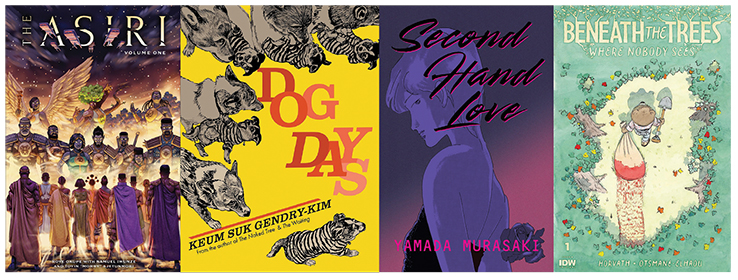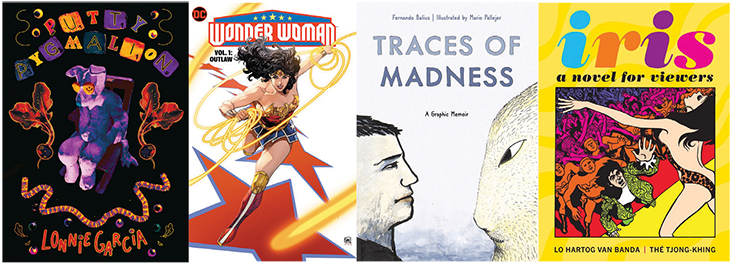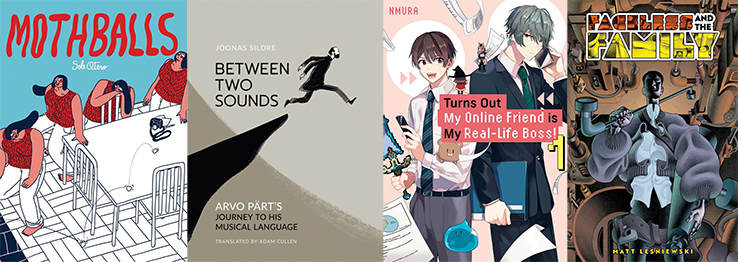Graphic Novels Preview | Forthcoming Reads and Format Trends
Comics play to their strengths this season, stressing layout and mood while also supporting reader interests in works of horror and adaptation.
The opportunity to experiment with line and form, matching design to mood and carrying story through innovative panel layout and art, clearly holds deep appeal for graphic novel creators and readers alike. Design of both story and page is the point in many of the key works this season. Frank Silva, marketing and communications coordinator at Mad Cave Studios, notes, “The trend of presenting stories in unconventional formats…showcases a growing interest in experimenting with narrative structures.” Look toward Attaboy, Iris, and Between Two Sounds for examples. At the same time, underscoring the format’s avid readership, trends from text-only fiction and nonfiction are finding equal home in graphic novels—particularly with a focus on horror, SFF, adaptations, and memoirs. A downloadable list of all titles mentioned can be found here.

Horror
As LJ has noted in multiple previews, horror has a tight grip on readers, and that is as true in graphic forms as it is in text-only novels. The genre continues to hold high appeal, with gripping stories that provide respite from a disordered world. Some highlights of the season include filmmaker Patrick Horvath’s debut Beneath the Trees Where Nobody Sees (IDW), in which cute critters are serial killers, and, from Ram V and Filipe Andrade, the team behind LJ Best Book The Many Deaths of Laila Starr, Rare Flavours (BOOM! Studios), about a demonic Rakshasa who dreams of being the next Anthony Bourdain. Award-winning Jeff Lemire and illustrator Andrea Sorrentino add to the Bone Orchard mythos with Bone Orchard: Tenement (Image Comics), which features a building’s residents bound together by secrets and facing supernatural and psychological horrors. Jazmine Joyner debuts with a retelling of the Anansi the Spider folktale in Devour (Megascope: Abrams ComicArts), illustrated by Anthony Pugh. Transgender parapsychologist Joy Ravenna finds working with ghosts far easier than dealing with the living in The Science of Ghosts (Legendary Comics), written by Lilah Sturges and illustrated by El Garing. There are also two coming-of-age horror stories: award-winning writer James Tynion IV, writer Tate Brombal, and illustrator Isaac Goodhart offer the first volume of The Oddly Pedestrian Life of Christopher Chaos (Dark Horse), in which Christopher realizes that the cute boy at school is a deadly creature, while The Nasty (Vault Comics) from John Lees and illustrator Adam Cahoon celebrates slasher films, as a group of teens film their own movie.
SFF
The full range of SFF continues to dominate graphic novels as well. From outer space to dystopian settings to magical fantasy to creature stories, what awaits readers is expansive and visually detailed. An ex–Space Marine trucker and his alien copilot travel the galaxy in Space Mullet (Image Comics) by Daniel Warren Johnson, while L. Pidge’s Infinite Wheatpaste, Vol. 1: Catalytic Conversions (Avery Hill) offers a universe-spanning sci-fi adventure. Dystopian worlds appear in Space Junk (Top Shelf Productions) by Julian Hanshaw and in Faceless and the Family (Oni) by Matt Lesniewski. There are also two charming fantasy stories to look forward to: Slightly Exaggerated (Dark Horse), written by Curtis Clow and illustrated by Pius Bak, about a treasure-hunting girl, and the hopepunk tale Disciples of the Soil (Avery Hill) from B. Mure. Beyond magic and space, there are Mutant Cats (Gungnir Entertainment) from Matthew Medney and Morgan Rosenblum, with art by Alex Arizmendi, and Bigfoot, Yetis, Nessies, and more in the anthology Project: Cryptid (Ahoy Comics).
Superheroes Known and New
This season, superheroes dominate screens large and small, as well as the pages of books, graphic and otherwise. Look for the return of familiar characters and a new wave of superheroes, plus a focus on modern powers gained in new ways. While fans wait for the Daredevil: Born Again TV series, they can read the new graphic novel Daredevil: Black Armor (Marvel) from D.G. Chichester and illustrator Netho Diaz. After watching The Marvels movie, fans will appreciate Captain Marvel: The Omen (Marvel), a new series from writer Alyssa Wong and illustrator Jan Bazaldua. Yelena Belova, who has also featured in the MCU recently, receives a solo comics series, White Widow: Welcome to Idylhaven, written by Sarah Gailey and illustrated by Alessandro Miracolo. In the DC world, Chip Zdarsky explores how Bruce Wayne became the Dark Knight in Batman: The Knight, Vol. 1, illustrated by Carmine Di Giandomenico. There’s Batman’s adversary in The Penguin, Vol. 1, from award-winning writer Tom King and artist Stefano Gaudiano. King also writes Wonder Woman: Outlaw, illustrated by Daniel Sampere.
Author and YouNeek Studios founder Roye Okupe points out that comics creators are “mirror[ing] real-world challenges, reflecting the complexities of humanity” in the new wave of superhero titles. Okupe and illustrators Samuel Iwunze, Toyin “Morby” Ajetunmobi, Sunkanmi Akinboye, and Etubi Onuchyo produce the Afrofuturist sci-fi fantasy The Asiri, Vol. 1 (Dark Horse). Okupe says, “With African-inspired content surging, the Asiriverse is a movement and a celebration of African culture through the lens of the superhero genre.” Eisner Award–winning writer Saladin Ahmed and artist Megan Levens team up for Starsigns (Image Comics), a new series about 12 ordinary people who gain superhuman powers after constellations fall to Earth. A supernatural being and a passing comet make wishes come true 35 years after the wishes are cast, including one kid’s wish to be a superhero, in Ilias Kyriazis’s What We Wished For (Humanoids). Other people unexpectedly gain superpowers after receiving organ transplants in Dave Collard’s comics debut, Transplants (Dark Horse), illustrated by Domenico Carbone. Whoopi Goldberg and Jaime Paglia also make their comics debut with the story of a grandmother who develops new abilities in The Change (Dark Horse), illustrated by Sunkanmi Akinboye.

Manga
Manga continues to be hugely popular, offering titles in every genre, with horror and romance dominating. New horror titles include Yumeya’s Shadows of Kyoto (Titan Manga; tr. from Japanese by Jonathan Clements and Motoko Tamamuro) and Junji Ito’s Alley (VIZ; tr. from Japanese by Jocelyne Allen), while in romance there’s Tsumuji Yoshimura’s Just Like Mona Lisa (Square Enix Manga; tr. from Japanese by Leo McDonagh) and Nmura’s Turns Out My Online Friend Is My Real-Life Boss! (Kodansha; tr. from Japanese by Melissa Chiam). Comics historian and Japanese translator Ryan Holmberg helps bring three notable titles to U.S. audiences: Oba Electroplating Factory (Drawn & Quarterly) by Yoshiharu Tsuge, Ninja Sarutobi Sasuke (New York Review Comics) by Shigeru Sugiura, and Second Hand Love (Drawn & Quarterly) by Yamada Murasaki.
Literary Fiction
Comics are a stronghold form across Europe and Asia and have long showcased the importance of translated fiction to U.S. readers. Fantagraphics in particular gifts readers with a global catalogue. As Eric Reynolds, VP & associate publisher of Fantagraphics points out, this wide scope of authors showcases “the very best work being created around the globe and the range of voices that the medium of comics is capable of and [offers] a counter-narrative to a history of comics as viewed through an American prism.” Braba: A Brazilian Comics Anthology (Fantagraphics; tr. from Portuguese by Andrea Rosenberg), edited by Rafael Grampá and Janaina de Luna, offers 13 stories that showcase the nation’s comics landscape. Argentine artist Sole Otero pens Mothballs (Fantagraphics; tr. from Spanish by Andrea Rosenberg), a family saga that juxtaposes the lives of a grandmother and granddaughter. Croatian artist Miroslav Sekulic-Struja follows a poet returned from army service and a dancer with a joy for life in Petar & Liza (Fantagraphics; tr. from French by Jenna Allen with Ana Šetka). Two more technicolor Fantagraphics works come from Northern European comics standouts: Finnish artist Tommi Musturi offers Future (tr. from Finnish by Tuomas Rantala), and Dutch artist Thé Tjong-Khing, along with author Lo Hartog van Banda, has the aptly titled Iris: A Novel for Viewers (tr. from Dutch by Laura Watkinson). Drawn and Quarterly highlights Irish artist Luke Healy with Self-Esteem and the End of the World and Kahnawá:ke artist Walter Scott’s The Wendy Award. Humanoids showcases French artist Samir Dahmani’s Seoul Before Sunrise (tr. from French by Nanette McGuinness). Lastly, Rescue Party: A Graphic Anthology of COVID Lockdown (Pantheon) edited by Gabe Fowler, collects over 140 single-page comics contributed by an international group of artists.
A Change of Form
Adaptations, a trending form across genres, are also making an impact on comics, with graphic translations and new takes on age-old stories. Medea (Dark Horse; tr. from French by Montana Kane) by Blandine Le Callet, with art by Nancy Peña, reclaims the story of the murderous mother, while Putty Pygmalion (Silver Sprocket) by Lonnie Garcia is a queer take on creating a life to love and serve the artist. In The Hidden Life of Trees: The Graphic Adaptation (Greystone), Fred Bernard, with illustrations from Benjamin Flao, remakes Peter Wohlleben’s best-selling science book about plant communication. Sōseki Natsume’s Botchan: The Manga Edition (Tuttle; tr. from Japanese by Makiko Itoh) by Sōseki Natsume and adapted by Kaori Okura transforms one of Japan’s most-read novels into manga. For moviegoers seeking more stories from Arrakis, there’s Dune: The Graphic Novel, Bk. 3; The Prophet (Abrams ComicArts), with text by Brian Herbert and Kevin J. Anderson and illustrations by Raúl Allén and Patricia Martín.

Memoir & Biography
True-life stories lead graphic nonfiction offerings, with a constant motif being wistful reflection on childhood’s pleasures and problems. Three to note include The Field (Conundrum) by Dave Lapp, The Flavors of Iraq: Impressions of My Vanished Homeland (Graphic Mundi: PSU; tr. from French by Kendra Boileau) by Feurat Alani (text) and Léonard Cohen (illus.), and Maple Terrace (Uncivilized) by Noah Van Sciver.
Another trend is medical memoirs. These “can reveal through [their] powerful sequence of words and images more about the…worlds of mental illness than can any clinical description,” says Kendra Boileau, assistant director/editor in chief and publisher of Graphic Mundi at Penn State University Press. “They foster understanding and inspire empathy. More importantly, they allow the author to draw out their own story, to name their own experiences. From this perspective, [they] can be a powerful act of defiance.” Just four of the many examples include Traces of Madness: A Graphic Memoir (Graphic Mundi; tr. from Spanish by Richard Beevor and Malién Sganga) by Fernando Balius (text) and Mario Pellejer (illus.), Proxy Mom: My Experience with Postpartum Depression (NBM) by Sophie Adriansen (text) and Mathou (illus.), Processing: 100 Comics That Got Me Through It (Drawn & Quarterly) by Tara Booth, and Brittle Joints (Street Noise) by Maria Sweeney.
Graphic biographies stand out this season for their focus on the arts. Look for Joonas Sildre’s Between Two Sounds: Arvo Pärt’s Journey to His Musical Language (Plough; tr. from Estonian by Adam Cullen), George Sand: True Genius, True Woman (SelfMadeHero; tr. from French by Edward Gauvin) by Séverine Vidal (text) and Kim Consigny (illus.); Vincent: A Graphic Biography (Frances Lincoln) by Simon Elliott, and The Giant: Orson Welles, the Artist and the Shadow (First Second) by Youssef Daoudi.
Big Names
Breaking big in 2017, winning the Ignatz Award and two Eisners, Emil Ferris’s My Favorite Thing Is Monsters finally gets its long-awaited sequel, My Favorite Thing Is Monsters, Bk. Two (Fantagraphics). With Dog Days (Drawn & Quarterly; tr. from Korean by Janet Hong), LJ Best-Booker and Eisner and Harvey Award winner Keum Suk Gendry-Kim (The Naked Tree) offers the story of dogs and a couple trying to make a home in a new place. David F. Walker and Marcus Kwame Anderson, Eisner winners for The Black Panther Party, offer a radically new retelling of The Adventures of Huckleberry Finn with Big Jim and the White Boy: An American Classic Reimagined (Ten Speed Graphic).
At least part of the year will focus on the art of comics, through three books by authors who have helped define the format. Adrian Tomine (Shortcomings) offers what amounts to a writing class with Q&A (Drawn & Quarterly). From the same publisher comes Chris Ware’s Acme Novelty Datebook, Vol. Three, the last in the multi-Eisner and Harvey Award–winning cartoonist’s facsimile sketchbook series. Charles Burns, best known for Black Hole, produces Kommix (Fantagraphics), a work that offers 80 images of imagined covers, and Final Cut (Pantheon), a horror/SF mashup about making art.
Scaffolding Stories
From meta considerations of the form to new superhero characters refreshing comics’ roots, the upcoming season has much to offer. As readers of text become visual readers of art and design as well, the format, as it has done throughout its history, continues to innovate its own construction, enthrall audiences, and transform literature.
RELATED
ALREADY A SUBSCRIBER? LOG IN
We are currently offering this content for free. Sign up now to activate your personal profile, where you can save articles for future viewing









Add Comment :-
Comment Policy:
Comment should not be empty !!!